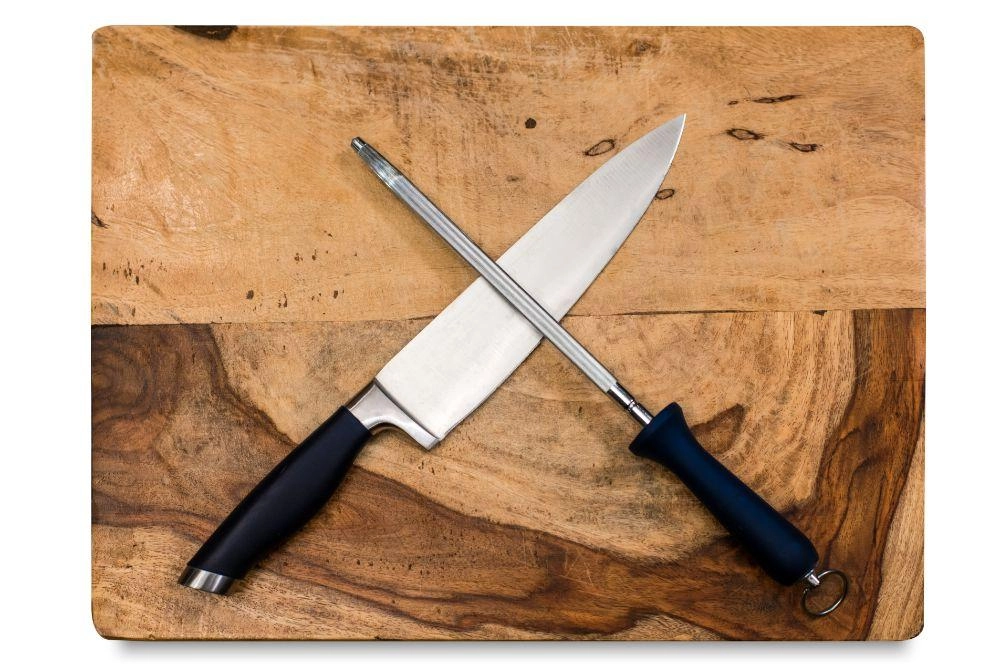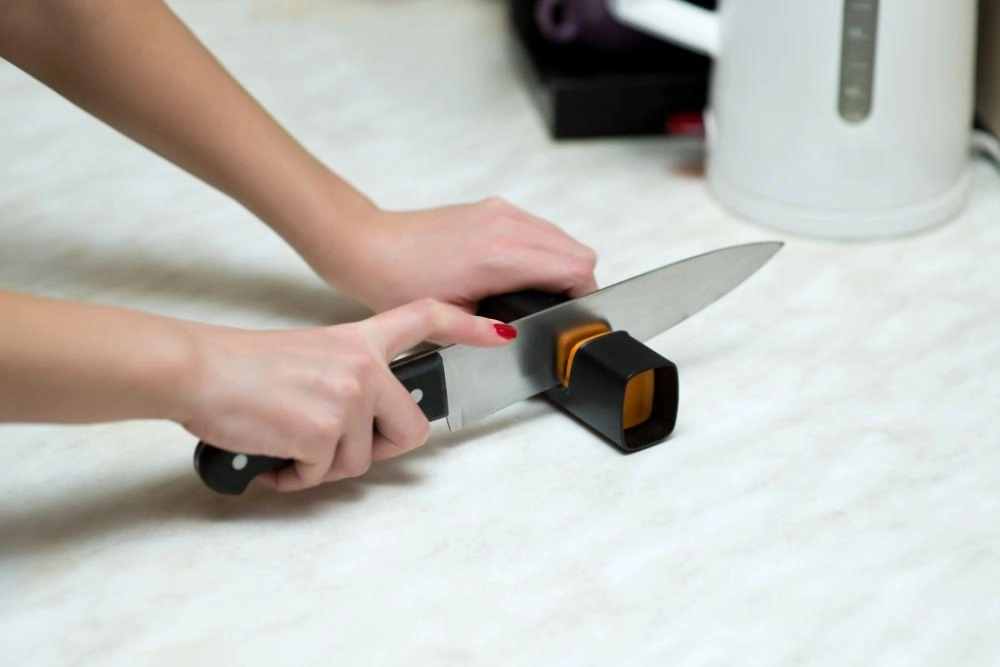A high quality knife block set is a treat for many home cooks. But with a lovely knife set comes the chore of sharpening knives so they perform properly and don’t create a slipping hazard.
A dull knife blade presents a much more serious risk than a sharp knife to the person using it. The dull knife requires more force to make the cut, which could result in the knife slipping and causing injury.
You may have heard about a self-sharpening knife block and wondered if this could be the solution. But how do self sharpening knives work, and is it the right choice for you?

One of the more traditional ways to sharpen knives is using a sharpening steel - which is a handheld cylindrical honing rod
The secret to self sharpening blades is all in the knife block. It differs from traditional knife blocks because within the knife block slots, there are ceramic sharpening mechanisms that sharpen the knife every time it is slid in or pulled out of its slot. Single self-sharpening knives usually come with a sharpening sleeve.
Keep reading to learn the answer to the question: how does self-sharpening cutlery work? As this may be the solution to your knife sharpening woes.
So in reality “self sharpening knives” don’t actually sharpen themselves, making the name misleading. It’s more accurate to say the knife storage doubles as an automatic sharpener. Nevertheless, it's still a handy invention for the home cook who finds their knives dulling often.
Henckels Self Sharpening Block
A self sharpening knife block uses internal ceramic edges designed to sharpen the knife to its ideal angle. Whether it's a paring knife, chef's knife, or utility knife, the knife block spot will have a ceramic sharpener inside, specifically designed to optimize the knife’s angle and keep it sharp.
If you have a ceramic knife sharpener, you know you slide the dull blade through the sharpener at certain angles to get a fine edge. It’s the same process, except that knife block does all the work while protecting your blades.
So why ceramic? Ceramic is a hard enough material that the knife won’t slice through or break the sharpener. But ceramic is also gentle enough that it can realign the blade, so it’s sharp again, without removing excess steel.
Some knife sharpeners, or technically all knife sharpeners, use hard metal or stone materials to slice the steel to make a new edge. Technically, using ceramic is honing the knife, not sharpening it.

A Handheld Knife Sharpener Puts a New Edge on Your Knife
Many people use sharpening as a synonym for honing, but honing is simply the realignment of the blade’s edge, while sharpening creates a new edge by removing steel from the knife.
These knife sets should really be called self-honing knife blocks, but either way, you get a knife that cuts through ingredients with ease and precision.
Most self-sharpening knife blocks use the same design, but there are a few options for the sharpening or honing material. Below is a brief explanation of each one.

A Self Sharpening Knife Block Has the Capability of Sharpening a Knife Blade as it is Put Back - or Removed From - the Knife Block
Ceramic is the most common and probably the best material for sharpening knives in a knife block. As mentioned, it’s gentle on the knives but tough enough to still work.
Ceramic is durable but affordable, making it the ideal material. In the end, ceramic is a sensical choice for most home cooks thanks to its affordability and effectiveness.
Henckels features multiple self sharpening knife blocks with ceramic wheels that do the sharpening when you remove a knife from the block - as well as when you put it back in the block.
There are also knife sets that self-sharpen using plastic edges inside the block. While plastic is cheaper than ceramic, it’s not as gentle as some may think, making it a poor choice for sharpening. Plastic will damage the knife more quickly, meaning the knife’s lifespan will shorten and need replacing sooner.
Some self-sharpening knives use a stainless steel block or sheath to realign and shave the edge of the knives. But these typically shorten the knife's lifespan, meaning you’ll have to get a new set sooner. Stainless steel knife blocks are also rare and expensive.
Wheatstone is what professionals typically use to sharpen knives. But using a standard Wheatstone takes skill and practice to correctly sharpen a knife. Some super fancy knife blocks use Wheatstone as the self-sharpening material, but these are expensive and not entirely necessary.
While a self-sharpening knife set may sound like a miracle, it has its downsides. Before running out and buying a self-sharpening knife set, weigh the pros and cons explained below, so you can make the right decision and purchase with confidence. After all, you can sharpen your knives in several other ways.
Self-sharpening knife blocks have several pros that make them very enticing. Consider if a self-sharpening knife set will make your cooking experience significantly better.
If you were wondering if the self-sharpening knife blocks actually work, the answer is yes! Many trusted brands like JA Henckels and Calphalon make excellent knife block sets, offering endlessly sharp knives for safe and precise chopping.
As discussed, sharpening knives is a pain. It’s just another chore. Self-sharpening knife sets eliminate this chore, making them a convenient kitchen hack that will save you time and effort.
In addition to the shelf-sharpening feature, the knife block itself is a major pro. Some people hang their knives on a knife magnet, while other people leave them in a cutlery drawer.
But these storage methods can create hazards, as someone may accidentally cut themselves on one of these exposed blades. But the knife block covers the blade, eliminating these hazards.
The worst thing you can do to your quality chef’s knives is leaving them loose in a cutlery drawer.
A knife block protects household members from the hazards of exposed blades, but it also protects the knives from extra wear and tear. A knife block, whether self-sharpening or not, will extend the lifespan of your knives.
Cons associated with self-sharpening knives are few, but they’re still worth mentioning. However, if you use the knives gently and purchase the best self-sharpening knife block, you shouldn’t experience these problems.
This con isn’t super prominent. However, if you replace or remove the knives forcefully from the block or at the wrong angle, you may damage the knife.
Most home cooks don’t slam their knives aggressively back into the knife block, so this shouldn’t be an issue for most people. But it’s best to be aware of this potential issue. Take your time putting the knives away, and always treat them with care.
A self-sharpening knife block may sharpen (or hone) your knives more often than necessary. Most professionals recommend honing your knives once every one to two weeks. But every time you insert or remove a knife from the block, it sharpens it.
If you have a particularly harsh self-sharpening knife block, it may damage the knives, shortening their lifespan. And when you buy a quality set of chef's knives, the last thing you want is to replace it just two years later.
Most self-sharpening knife blocks actually hone the knives rather than sharpen them. While honing knives is excellent because it makes them more functional without shortening their lifespan, many home cooks prefer their knives sharpened.
However, you can have your knives professionally sharpened annually and still utilize a self-sharpening knife block, so you get the best of both worlds.
If a self-sharpening knife block sounds like a dream, check out these three self-sharpening blocks and knife sets that you can add to your collection of handy kitchen tools. Read each knife's review to see if this knife block set is ideal for you.
JA Henckels is one of the most popular brands for self-sharpening knives. This set comes with twenty pieces, including paring knives and utility knives. Henckels features multiple self sharpening knife blocks with ceramic wheels that do the sharpening when you remove a knife from the block - as well as when you put it back in the block.
If you own a Calphalon knife, you know this brand makes quality products. The Calphalon Classic Self-Sharpening cutlery set is plentiful, with fifteen different knives. Each knife is high-carbon, no-stain steel that fits perfectly into the slot featuring a ceramic-sharpening mechanism.
The Zwilling Pro knife block set is ideal for someone who values quality over quantity. The block only has seven cutlery pieces, but the quality is impeccable and lasts a lifetime. The sharpeners in this block are high-quality stainless steel, and the knives are super durable and resistant to wear.
Buying Considerations
Keep the following considerations in mind when buying a knife set:
People often have many questions surrounding self-sharpening knife blocks. Below are the answers to other commonly asked questions on the topic.
Self-sharpening clipper blades are not blades used for cooking. Clipper blades are mostly for cutting hair and beards, but they also may be found in offices in paper cutters or similar appliances.
These self-sharpening blades use an inner mechanism as the blade rotates, eliminating any knicks or dullness. But self-sharpening knives and clipper blades work similarly.
Steak knives are another name for serrated knives. Serrated knives have sharp teeth that help tear through meat and other foods. But because of the teeth, there is no straight edge that needs sharpening.
Steak knives and other serrated knives, like bread knives, never need sharpening. They may need to be replaced after five to ten years if used heavily and not cared for well.
